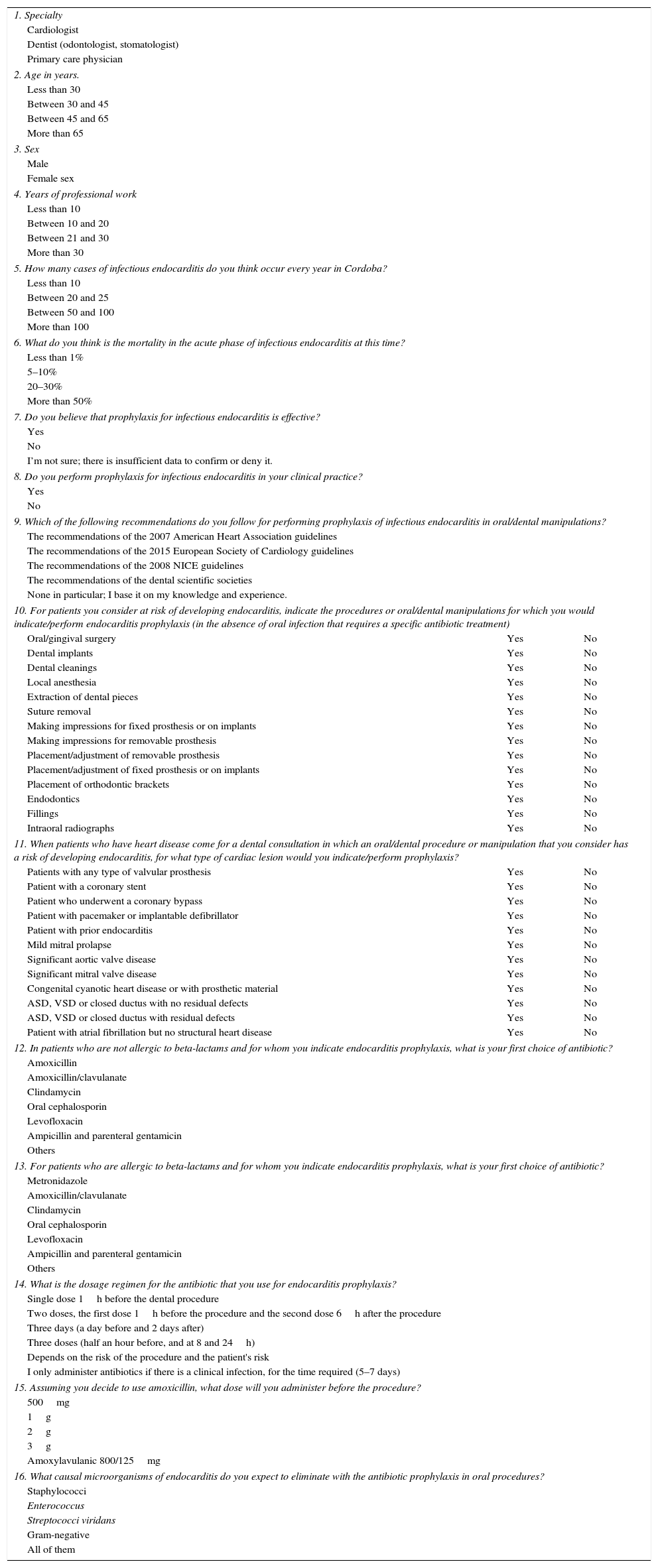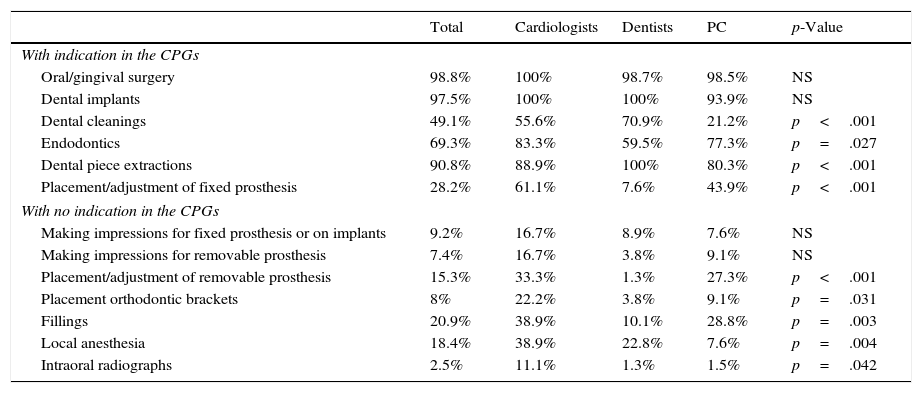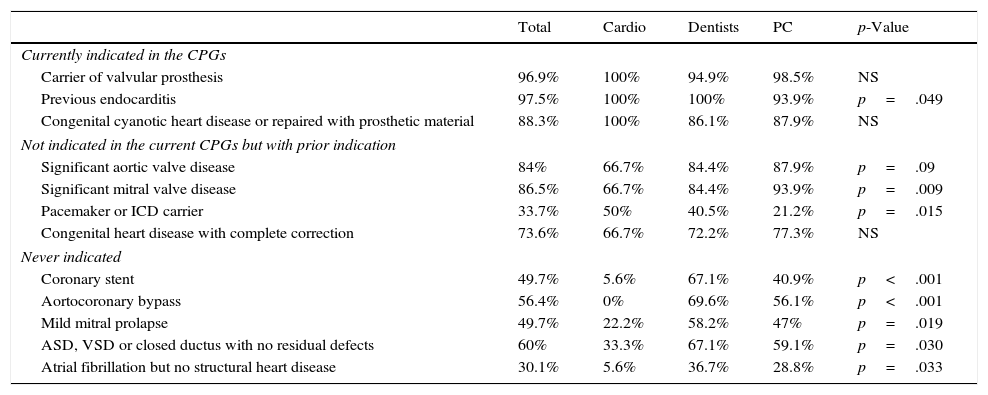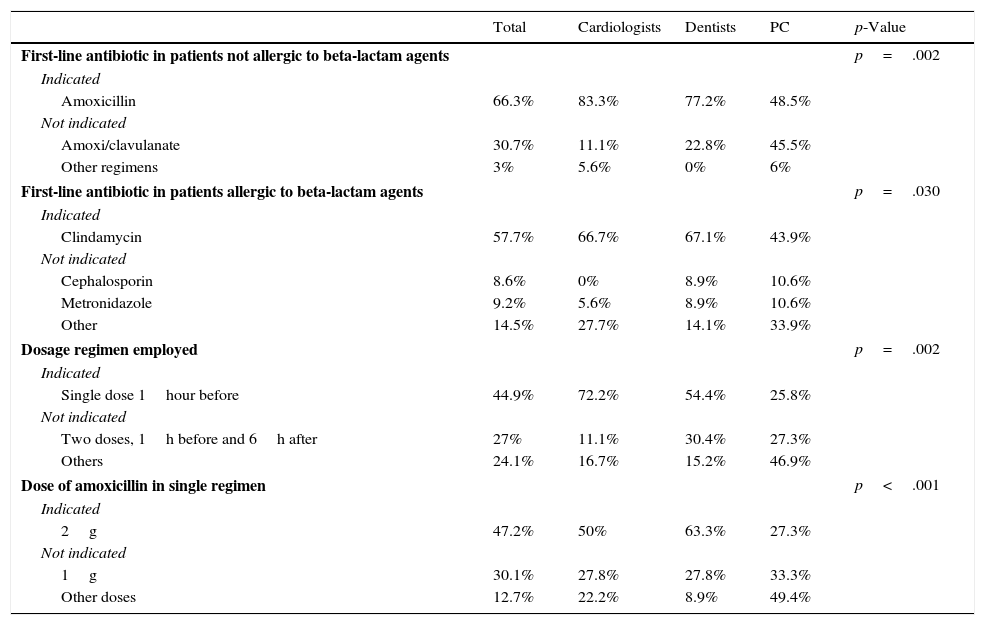The prophylaxis regimens for infectious endocarditis recommended by the clinical practice guidelines have recently changed. We do not know whether the current regimens are correctly followed in our setting. Our objective was to describe the approaches of various health professionals concerning these guidelines.
Materials and methodsWe conducted a survey in Cordoba, using a 16-item online questionnaire on this topic. We randomly selected a sample of 180 practitioners (20 cardiologists, 80 dentists and 80 primary care physicians), of whom 173 responded.
ResultsHalf of the participants were men; 52% had more than 20 years of professional experience. Some 88.3% of the participants considered that prophylaxis of endocarditis is effective (77.8% of the cardiologists, 93.7% of the dentist; p=.086). In general, prophylaxis is performed in conditions of clearly established risk (>90% of those surveyed). However, prophylaxis is also performed in a high proportion of cases with no risk of endocarditis, varying between 30 and 60% according to the procedure (mostly the dentists, between 36 and 67%, followed by the primary care physicians, between 28 and 59%). The antibiotic regimens employed varied significantly. The primary care physicians were furthest from the recommended regimen (only 25.8% used the recommended regimen vs. 54.4% of dentists and 72.2% of cardiologists; p=.002).
ConclusionsCompliance with the recommendations on prophylaxis for endocarditis should be improved in our setting. We observed a tendency, especially among noncardiologists, to “overindicate” the prophylaxis.
Las pautas de profilaxis de endocarditis infecciosa recomendadas por las guías de práctica clínica han cambiado recientemente. Se desconoce en nuestro medio si se siguen correctamente las pautas actuales. Nuestro objetivo es describir las actitudes de diferentes profesionales sanitarios ante ellas.
Material y métodosHemos realizado una encuesta en Córdoba, mediante un cuestionario online con 16 ítems sobre este tema. Se seleccionó aleatoriamente una muestra de 180 profesionales (20 cardiólogos, 80 dentistas, 80 médicos de atención primaria), de la cual contestaron 173.
ResultadosLa mitad eran varones, teniendo más de 20 años de ejercicio profesional el 52%. El 88,3% consideró que la profilaxis de endocarditis es efectiva (cardiólogos, 77,8%, dentistas, 93,7%, p=0,086). En general, se realiza profilaxis en las situaciones de riesgo claramente establecidas (>90% de los encuestados), pero también en una alta proporción de casos sin riesgo de endocarditis, que oscila entre el 30 y el 60% según los procedimientos (más los dentistas, entre el 36 y 67%, seguidos de los médicos de atención primaria, entre el 28 y 59%). Las pautas antibióticas usadas son muy variadas, siendo los médicos de primaria los que se alejan más de lo recomendado (solo un 25,8% usaban la pauta recomendada, frente a un 54,4% de dentistas y un 72,2% de cardiólogos, p=0,002).
ConclusionesEl seguimiento de las recomendaciones sobre profilaxis de endocarditis debe mejorarse en nuestro medio, observándose una tendencia, sobre todo en no cardiólogos, a una «sobreindicación» de la misma.
Article
Diríjase desde aquí a la web de la >>>FESEMI<<< e inicie sesión mediante el formulario que se encuentra en la barra superior, pulsando sobre el candado.

Una vez autentificado, en la misma web de FESEMI, en el menú superior, elija la opción deseada.

>>>FESEMI<<<










